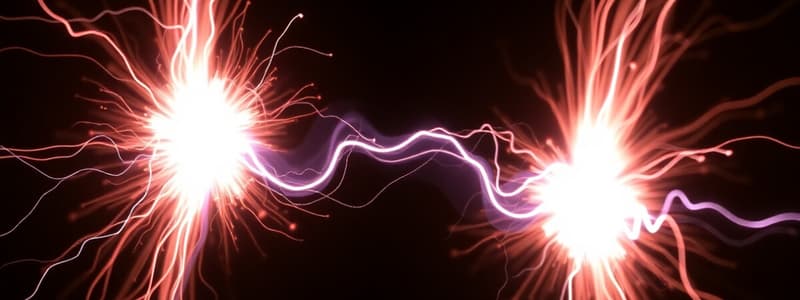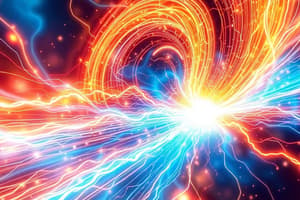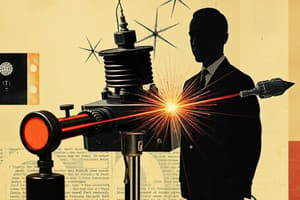Podcast
Questions and Answers
What happens to a compass needle when placed near a current-carrying wire?
What happens to a compass needle when placed near a current-carrying wire?
The needle deflects.
What two phenomena are linked by the magnetic effect of electric current?
What two phenomena are linked by the magnetic effect of electric current?
Electricity and magnetism.
What is the name for magnets that use the magnetic effect of electric current?
What is the name for magnets that use the magnetic effect of electric current?
Electromagnets.
Who discovered the relationship between electricity and magnetism?
Who discovered the relationship between electricity and magnetism?
In what year did Oersted make his discovery?
In what year did Oersted make his discovery?
What technologies were created from Oersted's research?
What technologies were created from Oersted's research?
What is the unit of magnetic field strength named in honor of Oersted?
What is the unit of magnetic field strength named in honor of Oersted?
What should the orientation of the wire be in relation to the plane of paper in activity 12.1?
What should the orientation of the wire be in relation to the plane of paper in activity 12.1?
What material is the wire made of in Activity 12.1?
What material is the wire made of in Activity 12.1?
According to the activity, what should be done after placing the compass near the wire?
According to the activity, what should be done after placing the compass near the wire?
How did Oersted's accidental discovery contribute to the understanding of the relationship between electricity and magnetism?
How did Oersted's accidental discovery contribute to the understanding of the relationship between electricity and magnetism?
Explain why a compass needle deflects when placed near a current-carrying wire.
Explain why a compass needle deflects when placed near a current-carrying wire.
Imagine you repeat Activity 12.1 using a thicker copper wire. How would you expect the deflection of the compass needle to change, assuming all other variables remain constant, and why?
Imagine you repeat Activity 12.1 using a thicker copper wire. How would you expect the deflection of the compass needle to change, assuming all other variables remain constant, and why?
If the current in Activity 12.1 is reversed, how would that affect the deflection of the compass needle?
If the current in Activity 12.1 is reversed, how would that affect the deflection of the compass needle?
What is the significance of Oersted's discovery in the development of modern technologies?
What is the significance of Oersted's discovery in the development of modern technologies?
How would increasing the current in the wire affect the magnetic field produced, and what effect would this have on the compass needle in Activity 12.1?
How would increasing the current in the wire affect the magnetic field produced, and what effect would this have on the compass needle in Activity 12.1?
Explain why the wire in Activity 12.1 is placed perpendicular to the plane of the paper and how this setup helps demonstrate the magnetic effect of electric current.
Explain why the wire in Activity 12.1 is placed perpendicular to the plane of the paper and how this setup helps demonstrate the magnetic effect of electric current.
What are some differences between permanent magnets and electromagnets, based on the context of the presented text?
What are some differences between permanent magnets and electromagnets, based on the context of the presented text?
In Activity 12.1, if the compass is moved farther away from the current-carrying wire, what happens to the deflection of the needle, and why?
In Activity 12.1, if the compass is moved farther away from the current-carrying wire, what happens to the deflection of the needle, and why?
How could you modify Activity 12.1 to investigate the relationship between the magnitude of the current and the strength of the magnetic field produced?
How could you modify Activity 12.1 to investigate the relationship between the magnitude of the current and the strength of the magnetic field produced?
Flashcards
Electric Current
Electric Current
Flow of electric charge through a conductor.
Magnetic Effect
Magnetic Effect
The influence of electric current that can deflect a magnetic compass needle.
Electromagnetism
Electromagnetism
The relationship between electricity and magnetism.
Hans Christian Oersted
Hans Christian Oersted
Signup and view all the flashcards
Compass Needle Deflection
Compass Needle Deflection
Signup and view all the flashcards
Resistor Activity
Resistor Activity
Signup and view all the flashcards
Magnetic Field Strength
Magnetic Field Strength
Signup and view all the flashcards
Electric Circuit
Electric Circuit
Signup and view all the flashcards
Electromagnet
Electromagnet
Signup and view all the flashcards
Link Between Electricity and Magnetism
Link Between Electricity and Magnetism
Signup and view all the flashcards
Deflection of Compass Needle
Deflection of Compass Needle
Signup and view all the flashcards
Electric Current-Carring Wire
Electric Current-Carring Wire
Signup and view all the flashcards
Oersted's Experiment
Oersted's Experiment
Signup and view all the flashcards
Magnetic Effect of Electric Current
Magnetic Effect of Electric Current
Signup and view all the flashcards
Electromagnetic Interaction
Electromagnetic Interaction
Signup and view all the flashcards
Magnetic Field
Magnetic Field
Signup and view all the flashcards
Activity to Observe Magnetic Effects
Activity to Observe Magnetic Effects
Signup and view all the flashcards
Historical Significance of Oersted
Historical Significance of Oersted
Signup and view all the flashcards
Unit of Magnetic Field Strength
Unit of Magnetic Field Strength
Signup and view all the flashcards
Compass Needle
Compass Needle
Signup and view all the flashcards
Study Notes
Magnetic Effects of Electric Current
- Electricity can produce a magnetic effect
- A current-carrying wire acts like a magnet
- Activity: Place a straight, thick copper wire in an electric circuit between points X and Y. The wire should be perpendicular to a compass placed nearby on a sheet of paper. Pass current through the circuit (by inserting a key). Observe the compass needle's position change.
- The compass needle deflects when current flows through the wire, demonstrating the magnetic effect of electricity.
- Electricity and magnetism are linked
- The reverse is also possible: moving magnets can produce an electric effect.
- The chapter will explore magnetic fields, electromagnetic effects, and electromagnets.
Hans Christian Oersted
- A key 19th-century scientist in understanding electromagnetism
- In 1820, Oersted accidentally discovered the connection between electricity and magnetism.
- He observed a compass needle deflecting when a current-carrying wire was placed nearby.
- This discovery linked electricity and magnetism.
- His work led to technologies like radio, television, and fiber optics.
- The unit of magnetic field strength ("oersted") is named in his honor.
Studying That Suits You
Use AI to generate personalized quizzes and flashcards to suit your learning preferences.




